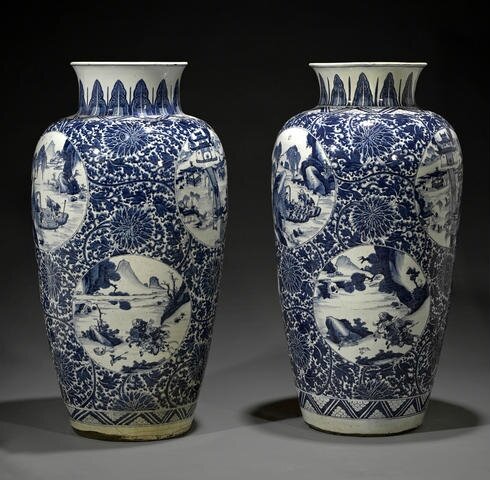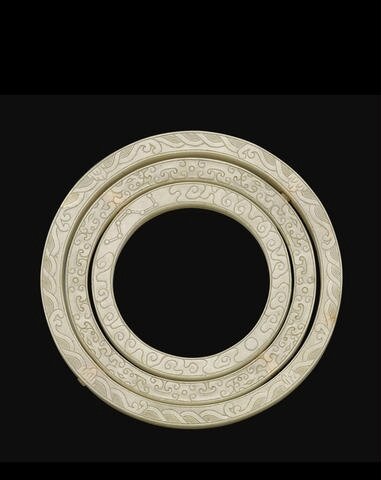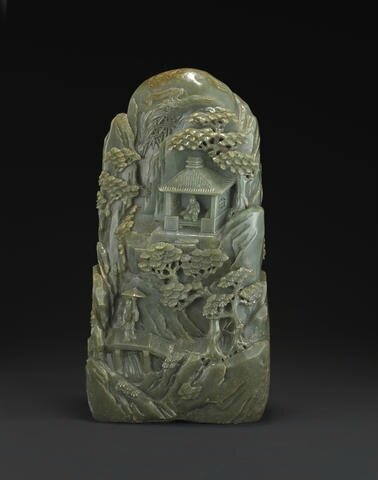Fine Kangxi Porcelain and Imperial Jades lead rich offerings at Bonhams San Francisco In June 24 Jun 2014
San Francisco — Two massive blue and white 'soldier' vases, formerly in the collection of Salvador Ugarte of Mexico City, stand out amongst a select group of Chinese Kangxi period porcelains to be offered at Bonhams San Francisco on June 24.
The term 'soldier' refers to the famous group of 151 Chinese blue and white porcelains which Augustus the Stone of Saxony received from Friedrich Wilhelm I of Russia in exchange for 600 Saxon dragoons in 1717. The vases, carrying a pre-sale estimate of $100,000-200,000, came through the famous New York gallery Ralph Chait in the 1950s to Mr. Ugarte's collection and were then acquired by their current owner in Mexico City.
Each formed with a flared neck of slightly different height but painted with the same upright leaf band on the exterior, triangular-sectioned band of pearls around the shoulder and above the base of the elongated ovoid body displaying composite lotus flowers and curly leaves surrounding six circular landscape reserves: the first of boatmen eating lunch on deck; the second of scholars on a hillside bluff near their rural retreat looking onto the hills, water and architecture around them; the third of huntsmen on horseback shooting their prey with arrows; the fourth a village complete with arching bridge to a ceremonial hall; the fifth of two skiffs with fisherman plying their nets; the sixth of two hunters on horseback with arrows, a hunting hawk and hunting dog; the lustrous glaze covering all surfaces except the wide foot and recessed base. 36 7/8in (93.5cm) high.
Provenance: the collection of Salvador Ugarte, Mexico City
Ralph Chait, New York, 1950s
Tall jars and vases of this type are often referred to assoldier or dragoon vases, after the famous group of 151 Chinese blue and white porcelains which Augustus the Strong of Saxony received in 1717 from Friedrich Wilhelm I of Prussia, in exchange for 600 Saxon dragoons. For surviving examples, now exhibited in the Bogengalerie at the Zwinger Pavilion, see Ulrich Pietsch, Anette Loesch and Eva Stroba, The Dresden Porcelain Collection: China, Japan, Meissen, 2006, p. 6 and pp. 18-19.
A pair of massive jars with covers from the same period sold in Bonhams & Butterfields, San Francisco, Sale 15409, 18 December 2007, lot 4368. For a single jar and cover with decoration similar to lot 4368, traceable to the original Saxon collection, see Bonhams, London, Sale 18827, 12 May 2011, lot 317; and another pair with domed covers sold in Bonhams, London, Sale 20580, 7 November 2013, lot 61.
They are joined by two rare large wucai enamelled jardinières, Kangxi six-character marks and of the period, offered at an estimate of $60,000-80,000. Brilliantly painted with peaches and song birds amidst pine and bamboo branches and deer walking amid faceted rocks, these exceptional pieces were formerly in the collection of Tang Shaoyi, the first premier of China.
Two rare large wucai enameled jardinières, Kangxi six-character marks and of the period. Estimate US$ 60,000 - 80,000 (€44,000 - 59,000). Photo Bonhams.
Provenance: formerly in the collection of Tang Shaoyi, first premier of China
The pine and bamboo decoration on the rim and recessed waist is related to two pale green glazed jardinières, of similar shape and size, in the Nanjing Museum: one, with birds on lychee branches illustrated in Xu Huping (ed), Zhongguo Qing Dai Guanyao Ciqi, 2003, p. 65; the other displaying birds on bamboo branches, published in the exhibition Qing Imperial Porcelain organized by the Nanjing Museum and the Art Gallery, Chinese University of Hong Kong, 1995, cat. no. 22. In both Nanjing examples, a shou medallion replaces the peach included in the rim band of this lot; but the recessed waist is filled with similar bamboo and pine branches.
Other variants in the recessed waist decoration on this group of large jardinières from the Kangxi period include flowering branches on the celadon glazed example with wucai enamel decoration in the Palace Museum, Beijing: see The Complete Treasures of the Palace Museum,Wucai, Doucai (Porcelains in Polychrome and Contrasting Colors), 1999, cat. no. 149, p. 163. A third pattern, of lotus flowers and leaf sprays, fills the recessed waist of a famille verte enameled jardinière sold in Christie's, Hong Kong, Sale 2369, 29 May 2007, lot 1492. A fourth example with Hundred Crane decoration in wucai enamels on the walls and recessed waist was sold in Sotheby's, London, sale 517, 14 November 2000, lot 170.
Fine jades from American private collections feature choice objects from the Qianlong period. A very rare carved white jade three-ring armillary disc (hunyi), based upon an instrument of astronomical observation, tops the offerings at a conservative pre-sale estimate of $80,000-120,000.
A rare carved white jade three-ring armillary disc, hun yi, 18th century. Estimate US$ 80,000 - 120,000 (€59,000 - 88,000). Photo Bonhams.
This three-section disc is based on an armillary sphere, an instrument of astronomical observation, known in China since the Han period. Metal versions from the Qing court were included in the 2005 exhibition China: The Three Emperors, organized by the Royal Academy, London: see, for example, the small armillary sphere of silver gilt and sandalwood, inscribed with the name of Ferdinand Verbiest, one of the Jesuits at the court of Kangxi, and dated by inscription to 1660, cat. no. 86, p. 195 and p. 411. Another example, possibly meant as a curiosity rather than a functioning instrument, is the sphere painted on a table behind a beauty holding a time piece, one scroll from a set of twelve beauties painted for the future Yongzheng emperor, included in the same exhibition as cat. no. 173, illustrated and discussed on p. 258 and pp. 431-432.
See also the painting Jiuzhou ruyi tu (all things good on earth) by the court painter, calligrapher and poet Wang Chengpei (c. 1725-1805), published in the 2002 exhibition organized by the Macau Museum of art, Hai guo bo lan : Qing dai gong ting xi yang chuan jiao shi hua shi hui hua liu pai jing pin (The golden exile : pictorial expressions of the school of western missionaries' artworks of the Qing dynasty court), cat. no. 58. The painting includes a small bronze armillary sphere on a stand, along with auspicious blossoms arranged in vases, a jade ruyi scepter and and smaller bronze container meant to complement the two-line poem composed by the Qianlong emperor.
The only example in jade, comparable to this lot, was sold in Sotheby's, Hong Kong, HK0372, 8 April 2011, lot 2804.
A fine and impressive large spinach jade boulder, 18th/19th century from a Bay Area collection, features a continuous scene showing a contemplative scholar in an open hut enclosed by shattered peaks and pines. Offered at an estimate of $60,000-80,000, this massive boulder is showcased in more than 100 lots of fine jades to be sold.
An impressive large spinach jade boulder, 18th-19th century. Estimate US$ 60,000 - 90,000 (€44,000 - 66,000). Photo Bonhams.
Of vertical profile, the massive ovoid form boulder skillfully and extensively carved with a continuous scene depicting a remote mountainous setting, with a contemplating scholar seated in an open hut by a cliff surrounded by pine and wutong trees, another bearded figure crossing a bridge above a meandering river, the reverse exhibiting an auspicious scene of a deer running towards a pine, and a crane in flight; the olive toned green matrix cast with patches of russet inclusions. 15 1/2in (39.4cm) high
Other examples include a white jade brushpot, estimated at $60,000-90,000 from the collection of Harold E. Stack, and a fine archaistic carved jade libation vessel, 17th/18th century, formerly in the collection of Dr. Hugh Shire, and exhibited in the Victoria and Albert Museum in 1975, as part of the Council of Great Britain and the Oriental Ceramic Society.
An inscribed white jade brush pot. Estimate US$ 50,000 - 70,000 (€37,000 - 52,000). Photo Bonhams.
Provenance: Spink & Son Ltd., London, 29 October 1986
The inscription to the right of the ceremonial hall reads and translates as:
bie ye ju you chu,
xian lai sheng yin xin.
nan shan dang hu yong,
feng shui ying yuan ling.
'Retired, I now live in a secluded place,
when there is leisure time I feel like being a hermit.
Mount Zhongnan is right in front of my lattice window,
and the gardens are reflected in the River Feng.'
The inscription is an excerpt from a poem by the famous Tang dynasty hermit Zu Yong. Although he was successful in the official examinations, achieving the title of jinshi in 724, Zu was never appointed with any official titles and decided to live in seclusion with other reclusive scholars.
The second inscription above the other assembly of scholars is an excerpt from a poem by the Tang scholar Bai Juyi (772 846), which also records the pursuit of a casual and free life by reclusive scholars.
The Zhongnan mountains (also known as Taiyi mountains) are a branch of the Qin Mountains located in Shaanxi Province, south of Xian, which was a crucial Daoist location. Located within these mountains is Lou Guan Tai, where the famous Daoist sage Laozi is said to have resided. The Zhongnan mountains have been a popular dwelling place for Daoist hermits since the Qin dynasty. As the mountains were in very close proximity to the ancient capital of Changan, officials who incurred the imperial court's wrath often fled to these mountains to escape punishment.
For a white jade brush pot with figures in landscape from the Qing court collection, preserved in the Palace Museum, Beijing, see The Complete Collection of Treasures of the Palace Museum: Jadeware II, 2008, no. 197, p. 236.
An archaistic carved jade libation vessel, 17th-18th century. Estimate US$ 20,000 - 30,000 (€15,000 - 22,000). Photo Bonhams.
Supported on an oval foot, its deep U-shaped body slightly waisted toward its rim, the elegantly channelled spout, opposing a pierced and deeply undercut handle in the form of a chilong climbing up to the rim, a smaller chilong coiled at its side, the exterior walls with incised and subtly raised bands of cloud scrolls and additional chilong between key-fret and vertical lappet patterns; the stone of a pale green tone, with patches of russet markings. 4 7/8in (12.4cm) high
Provenance: formerly in the Collection of Dr. Hugh Shire
Published: John Ayers and Jessica Rawson, Chinese Jade throughout the Ages, Oriental Ceramic Society, London, 1975, plate 311, p. 97, as Yuan/Ming dynasty; andTransactions of the Oriental Ceramic Society vol. 40 (1973-1975), same pagination.
A rare limestone standing figure of a bodhisattva, Tang dynasty, from the Kenneth and Harle Montgomery Foundation, highlights the early Chinese works of art offered in this session. The impressive figure, standing in tribhanga pose on a tiered lotus pedestal base, closely related in style to figures from Shaanxi province, has been in the family residence prior to 1970 and carries a pre-sale estimate of $100,000-150,000.
A rare limestone standing figure of a bodhisattva, Tang dynasty, with later elements. Estimate US$ 100,000 - 150,000 (€74,000 - 110,000). Photo Bonhams.
Property from the Kenneth and Harle Montgomery Foundation
The present figure appears to be closely related in style to figures in the Longmen cave temples near Luoyang in Henan province. Compare the example from one of the Longmen grottoes, illustrated in Li Yin, Treasure of Ancient Chinese Sculptures, Taipei, 1997, p. 62. See another Tang figure from Shaanxi province exhibiting similar features in Osvald Siren, Chinese Sculptures from the Fifth to the Fourteenth Century, Bangkok, 1998, pl. 413A. Another example related in style but smaller from the Shanghai Museum is illustrated inAncient Chinese Sculpture Gallery, The Shanghai Museum, Shanghai, 1996, pl. 59.
The present sculpture has been in the United States and in the current family's possession prior to 1970.
The 380 lot auction also features fine snuff bottles from a private San Francisco collection, Chinese robes and textiles from American collections, and scholar's objects and choice huanghuali furniture from the O'Brien collection of Asian art. Chinese paintings, featuring classical and modern works including Zhang Daqian, Huang Junbi and Qi Baishi will close the session.
The sale will be followed on June 25 by a 600-lot session of Asian Decorative Art.

/https%3A%2F%2Fprofilepics.canalblog.com%2Fprofilepics%2F1%2F0%2F100183.jpg)
/https%3A%2F%2Fstorage.canalblog.com%2F03%2F02%2F119589%2F96711876_o.jpg)
/https%3A%2F%2Fstorage.canalblog.com%2F11%2F31%2F119589%2F94773502_o.jpg)
/https%3A%2F%2Fstorage.canalblog.com%2F20%2F83%2F119589%2F94772815_o.jpg)
/https%3A%2F%2Fstorage.canalblog.com%2F26%2F72%2F119589%2F75604929_o.jpg)
/https%3A%2F%2Fstorage.canalblog.com%2F59%2F60%2F119589%2F26458628_o.jpg)









/http%3A%2F%2Fstorage.canalblog.com%2F79%2F84%2F119589%2F121121505_o.png)
/http%3A%2F%2Fstorage.canalblog.com%2F80%2F42%2F119589%2F120611565_o.jpg)
/http%3A%2F%2Fstorage.canalblog.com%2F79%2F49%2F119589%2F113206128_o.jpg)
/http%3A%2F%2Fstorage.canalblog.com%2F80%2F78%2F119589%2F113206111_o.jpg)